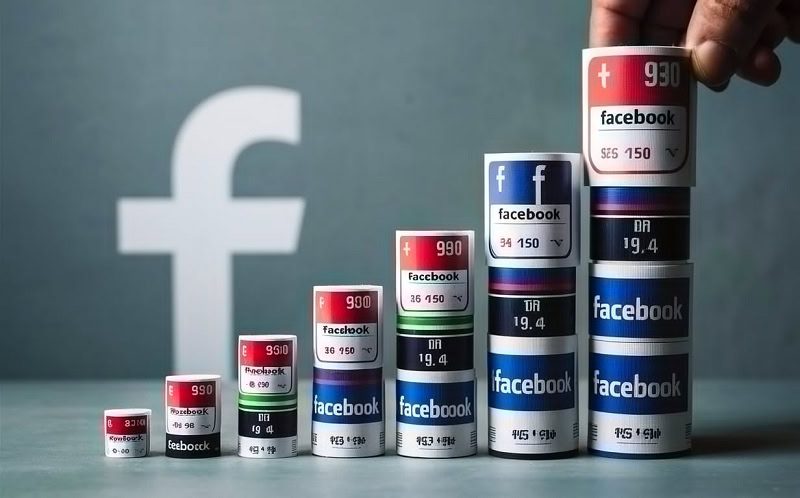
About author: Paulina Poliszewska leverages her expertise in media buying to optimise paid campaigns, ensuring maximum ROI and successful outcomes for DTC brands.
The shoot’s done. The photos and videos are edited. And you’re left with the most beautiful ad creative you’ve ever laid eyes on.
With bated breath, you launch your Facebook ad campaign, ready to unleash your products to the world. But nothing happens.
The cold, hard truth is that if your ad doesn’t drive clicks, it doesn’t matter how great your landing pages are – they’re not going to get the traffic they need to truly perform.

Boost E-Commerce ROI: Download Our Free CPA & ROAS Calculator
But what is a good Facebook ads CTR, and what can you do to improve yours?
In this article, we take a closer look, giving you everything you need to optimise your ads and start driving the results you need.
What CTR Means on Facebook
The Facebook advertising landscape is ultra-competitive, with brands constantly battling for the attention of their audiences. Click-through rate (CTR) serves as a key metric that helps advertisers understand how effective their content is at cutting through the noise and standing out from their competitors.
At its core, Facebook CTR is the ratio of users who click on a specific link to the number of total users who viewed it. It’s essentially a gauge of your ad’s effectiveness and appeal.
But why is it so important?
Well, a higher CTR indicates that more people are clicking through to see your content, suggesting that your ad is attractive and resonates well with your audience.
In the grand scheme of things, CTR can be a solid sign of your ad’s success or, alternatively, a signal that it’s time to return to the drawing board.
Average Facebook CTRs
Facebook advertising is a dynamic landscape that’s constantly evolving.
However, knowing the average CTRs is like having a trusty compass to guide you through this captivating digital wilderness.
According to the latest data, the average CTR on Facebook sits at 0.92%, but this can depend heavily on several key factors, including the quality of your ad creative and the industry you’re in.
In one of their leading benchmark reports, Instapage mapped this data out across multiple industries:
Source: Instapage
Here’s that data ordered from lowest CTR to highest:
| Industry | CTR % |
| Employment & Job Training | 0.47 |
| Finance & Insurance | 0.56 |
| Consumer Service | 0.62 |
| Home Improvement | 0.7 |
| Industrial Services | 0.71 |
| Education | 0.73 |
| B2B | 0.78 |
| Auto | 0.8 |
| Healthcare | 0.83 |
| Travel & Hospitality | 0.9 |
| Real Estate | 0.99 |
| Fitness | 1 |
| Technology | 1.04 |
| Beauty | 1.16 |
| Apparel | 1.24 |
| Retail | 1.59 |
| Legal | 1.61 |
So, what are the numbers telling us?
Based on the above Instapage data, the average CTR for Facebook floats at around 0.92%. If you’re in Apparel, general Retail or Legal, you’re in luck – you’re in with a strong chance of drawing CTRs of 1.24% and beyond.
If you’re in Employment & Job Training, Finance & Insurance or Consumer Services, however, you’re not so lucky – at 0.47-0.62%, your CTRs could be as low as half the general average.
But don’t just take the averages at face value. Conduct in-depth research to understand the nuances of your specific industry. You’ll find that these averages can provide a baseline, but your unique brand voice, value proposition, and target audience will significantly influence your personal CTR results.
What is a Good CTR on Facebook?
As we break down the average CTRs by industry, we can see that giving a flat percentage everyone should shoot for can be a bit misleading. While leading industries like legal have a strong chance of crushing the global average, Finance is going to have a tough time keeping up.
So, as a general rule, we recommend setting your CTR goal as your industry average to start with. From here, we recommend that you push yourself and raise that average by 15%.
Here’s how that looks for your industry:
| Industry | Average CTR % | Upbeat’s Recommended CTR: |
| Employment & Job Training | 0.47 | 0.54 |
| Finance & Insurance | 0.56 | 0.64 |
| Consumer Service | 0.62 | 0.71 |
| Home Improvement | 0.7 | 0.81 |
| Industrial Services | 0.71 | 0.82 |
| Education | 0.73 | 0.84 |
| B2B | 0.78 | 0.90 |
| Auto | 0.8 | 0.92 |
| Healthcare | 0.83 | 0.95 |
| Travel & Hospitality | 0.9 | 1.04 |
| Real Estate | 0.99 | 1.14 |
| Fitness | 1 | 1.15 |
| Technology | 1.04 | 1.20 |
| Beauty | 1.16 | 1.33 |
| Apparel | 1.24 | 1.43 |
| Retail | 1.59 | 1.83 |
| Legal | 1.61 | 1.85 |
Once you’ve hit your benchmark, think bigger.
Consider setting an ambitious goal for your CTR. After all, it’s a competitive landscape out there, and a strong CTR can catapult your brand to new heights, driving the results you need to make those tricky cost-per-clicks worth it.
But remember, a good CTR doesn’t just magically happen. It is meticulously crafted through rigorous testing, iterative processes, and a deep understanding of your target audience’s wants and needs. If you’re struggling to hit your benchmarks, it could be worth seeking help from a Facebook advertising agency.
How to Calculate CTR
The maths behind calculating your CTR is pretty straightforward but no less important to know. If you want to calculate your CTR, here’s how to do it:
CTR = (Number of Clicks/Number of Impressions)×100%
This formula will give a solid indication of your campaign performance, revealing insights into how many viewers felt compelled to take action and interact with your content.
Delve deeper by experimenting with different variations of your ad, analysing the results, and tweaking your strategy accordingly. Remember, a well-calculated CTR isn’t just a number – it’s the key to understanding and engaging your audience more effectively.
How to See Your CTR on Facebook
Follow these quick and easy steps to reveal the CTRs of your Facebook ad campaigns:
- Log into Facebook Ads Manager
You can also find this on the left-hand menu from your main Facebook home page:
- Select “Ads” from the top Ads Manager menu
- Pick the time frame you want to view CTRs for
- Select “Performance and Clicks” from the “Columns” tab
- [Alternative] click on the “+” symbol on the far right column
- Pick “CTR” in the Performance section and select it
There you have it. You’ll now be able to view your CTRs directly within your Ads Manager without having to delve into individual campaigns.
Clicks (all) vs Link Clicks vs Outbound Clicks – what’s the difference?
We’ve covered general Facebook CTRs, but things get a little more detailed than that. In fact, Facebook lets you split your CTRs into three different categories:
- Clicks (all)
- Link Clicks
- Outbound Clicks
But what are the differences between them? Let’s take a quick look:
| CTR Type | Definitions |
| Clicks (all) | This encompasses all clicks on Facebook, regardless of whether it’s an internal or external link. This is the CTR type we’ve been discussing in this article. Clicks (all) is great for measuring the overall engagement on an ad. |
| Link Clicks | This encompasses all clicks on links, regardless of whether they’re outbound to a landing page or inbound to a Facebook page or lead form. Link Clicks are useful for measuring on-platform engagement, which is often more affordable than taking users off-platform. |
| Outbound Clicks | This encompasses all clicks that take visitors off of the Facebook platform, whether that’s to an app or a website. If you’re looking to drive traffic or conversions on one of your own channels, Outbound Clicks will help you measure this more accurately. |
You can adjust these columns in Ads Manager by scrolling to the far right column and clicking the “+” sign to access the menu shown above.
7 Ways to increase Facebook ads CTR
We’ve talked about what a good Facebook CTR is – now we’re at the point where strategy meets execution. Below are some expanded tips on increasing your Facebook Ads CTR:
- Craft headlines that resonate
On a crowded social platform packed with compelling content, your ad creative needs to be a magnetic force.
Crafting headlines that are not just snappy but resonate with your target audience requires a blend of creativity and market research. Dive deep into your audience’s preferences, desires, and pain points to craft headlines that strike a chord.
How to make it happen:
- Know your audience: Use Facebook’s Audience Insights to get an understanding of your audience’s demographics, interests, and behaviours.
- Brainstorm multiple headlines: Write at least 10-15 headlines for each ad, playing with different angles.
- Use numbers and power words: Numbers often catch attention, and power words like “Discover,” “Unveil,” and “Secrets” can spark curiosity.
- Test and refine: Always A/B test your headlines to identify which one garners a higher CTR.
Headlines are the digital handshake for your brand, and you need to get it right. Experiment with different tones, words, and structures to find that golden headline that works wonders.
2. Leverage the power of visual storytelling
The power of visuals in storytelling is undeniable. With our brains processing visuals 60,000 times faster than text, the right image or video speaks directly to the viewer’s emotions and psyche. Correctly leveraging visual storytelling can be the difference between a quick scroll-past and a valuable click-through.
How to make it happen:
- Use high-quality images: This is non-negotiable. Blurry or pixelated images can damage brand credibility.
- Infuse brand Identity: Ensure your visuals resonate with your brand’s colours, themes, and ethos.
- Use video: Facebook users engage well with video content, especially ones that are informative yet concise.
- Test different formats: Carousel ads, videos, or single, static images – experiment to see what resonates most.
With our brains being visual powerhouses, the right imagery can make all the difference. Invest in visuals that are not just aesthetically pleasing but strategically aligned with your message and you’ll start to see your CTR track in the right direction.
3. Dive deep into audience understanding
If you want to craft ads that drive clicks from your target audience, you need to know their likes, dislikes, and what makes them tick.
Develop buyer personas, conduct surveys, and use Facebook Insights to gather invaluable data on your target demographic. Utilize this data to craft messages that speak directly to your audience, fostering a deeper connection and encouraging more clicks.
How to make it happen:
- Develop Bbuyer personas: Sketch out the typical profiles of your customers, including demographics, interests, and pain points.
- Survey your audience: Use tools like Jotform Survey Maker, Google Forms or SurveyMonkey to directly gather insights.
- Adjust targeting: Refine ad targeting based on gathered insights to ensure you’re reaching the right people.
Tailored messaging is the key to resonating with your audience. With a better understanding of who your audience is, ads can be customized to echo their preferences and pain points.
In addition to key demographic information, Facebook Audience Insights will give you detailed insights into the types of people clicking on your ads. This is gold dust for campaign optimisation.
- Deploy multi-dimensional testing strategies
It’s bleak, but true – nothing good lasts. Sadly, the same can be said for Facebook Ad campaigns.
In the world of advertising, the creative that’s crushing it today might run dry tomorrow. As a result, if you’re not constantly testing, you’re opening yourself up to issues and reducing the potential longevity of your campaigns.
How to make it happen:
- Start with A/B testing: Test single variables like images or headlines to determine which one attracts more clicks.
- Advance to multivariate testing: Examine multiple combinations of ad elements to pinpoint the most effective mix.
- Periodically review results: Track metrics and adjust campaigns accordingly.
- Don’t fear failure: Every test gives insights, even if the results aren’t as expected.
Testing is the backbone of a robust Facebook advertising strategy. Don’t just settle for A/B tests – consider multivariate testing to understand how different elements interact with each other. Analyse the data you get back, and use these valuable insights to inform your strategy moving forward.
- Create urgency – coupled with value
Creating a sense of urgency is a classic yet effective strategy in the advertising playbook. If you can take that a step further by coupling urgency with value, you’ll have a truly potent mix.
Humans are hardwired to fear missing out. When urgency meets value, it creates a compelling call to action that’s hard to resist.How to make it happen:
- Time-limited offers: Promote sales or discounts that have a clear end date.
- Stock indicators: Show limited stock or availability to prompt quicker decision-making.
- Flash sales or events: Advertise short, intense selling periods or special events.
- Use phrases that indicate urgency: Words like “Now,” “Today,” and “Only” can pressurise action.
6. Craft a CTA that converts
Easier said than done, but this couldn’t be more important for getting those vital clicks.
A compelling call-to-action is the gateway to conversions, urging users to take that decisive step. But a successful CTA goes beyond just a vibrant button against your Facebook ad creative. It’s a culmination of a well-thought-out strategy, where the copy, design, and placement work in harmony to guide users towards that all-important purchase.
To perfect your CTAs, adopt these best practices:
- Use action-oriented verbs: words like “discover,” “get,” and “start” inspire action.
- Make it stand out: use contrasting colours within your creative and ensure the CTA is clearly visible.
- Convey urgency or benefit: tell users why they should click now.
- Test different CTAs: A/B test different phrases, designs, and placements to find the most effective one.
Remember – the perfect CTA doesn’t just tell your audience what you want them to do – it motivates and inspires them to take the next step.
7. Optimise landing pages for higher conversions
Your Facebook ad CTR isn’t the end of the journey – it’s the beginning. If you want to turn those clicks into action, you need to optimise your landing page for conversions, too.
To craft landing pages that convert, follow these insights:
- Maintain consistency: The messaging and design between the ad and the landing page should be consistent.
- Ensure mobile optimisation: With a growing number of users on mobile, ensure the landing page loads and functions flawlessly on smartphones.
- Clear call-to-actions: Guide users with a distinct and compelling CTA.
- Swift loading times: Users expect pages to load quickly, especially on mobile.
Ensure that your landing pages aren’t just visually appealing, but also user-friendly, with clear CTAs, concise content, and a seamless navigation experience. Each element should work synergistically to encourage users to take the desired action.
Getting Started
There you have it – everything you need to know about Facebook ads CTRs.
As you begin your ads optimisation journey, remember that the path to CTR success is paved with meticulous planning, strategic thinking, and continual learning.
So arm yourself with the latest knowledge, keep in touch with industry trends, and foster a culture of continual learning and growth within your brand.
Related
- The Best Time To Run Facebook Ads: Maximise Your ROI
- 5 Benefits of Facebook Lookalike Audiences







